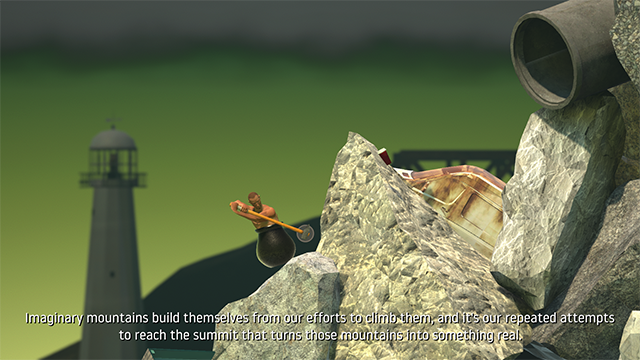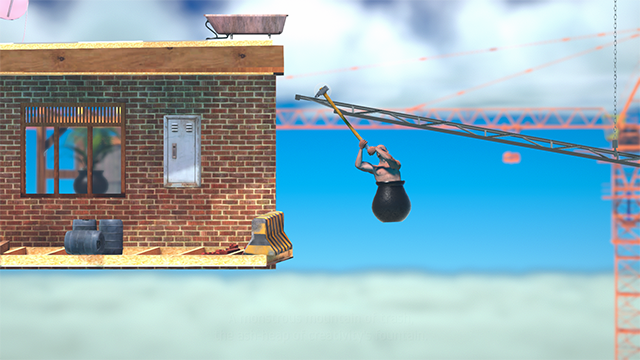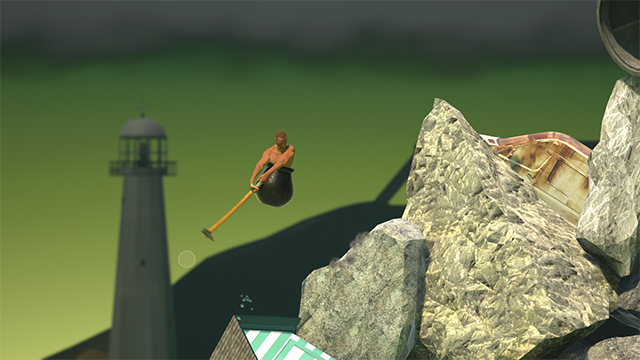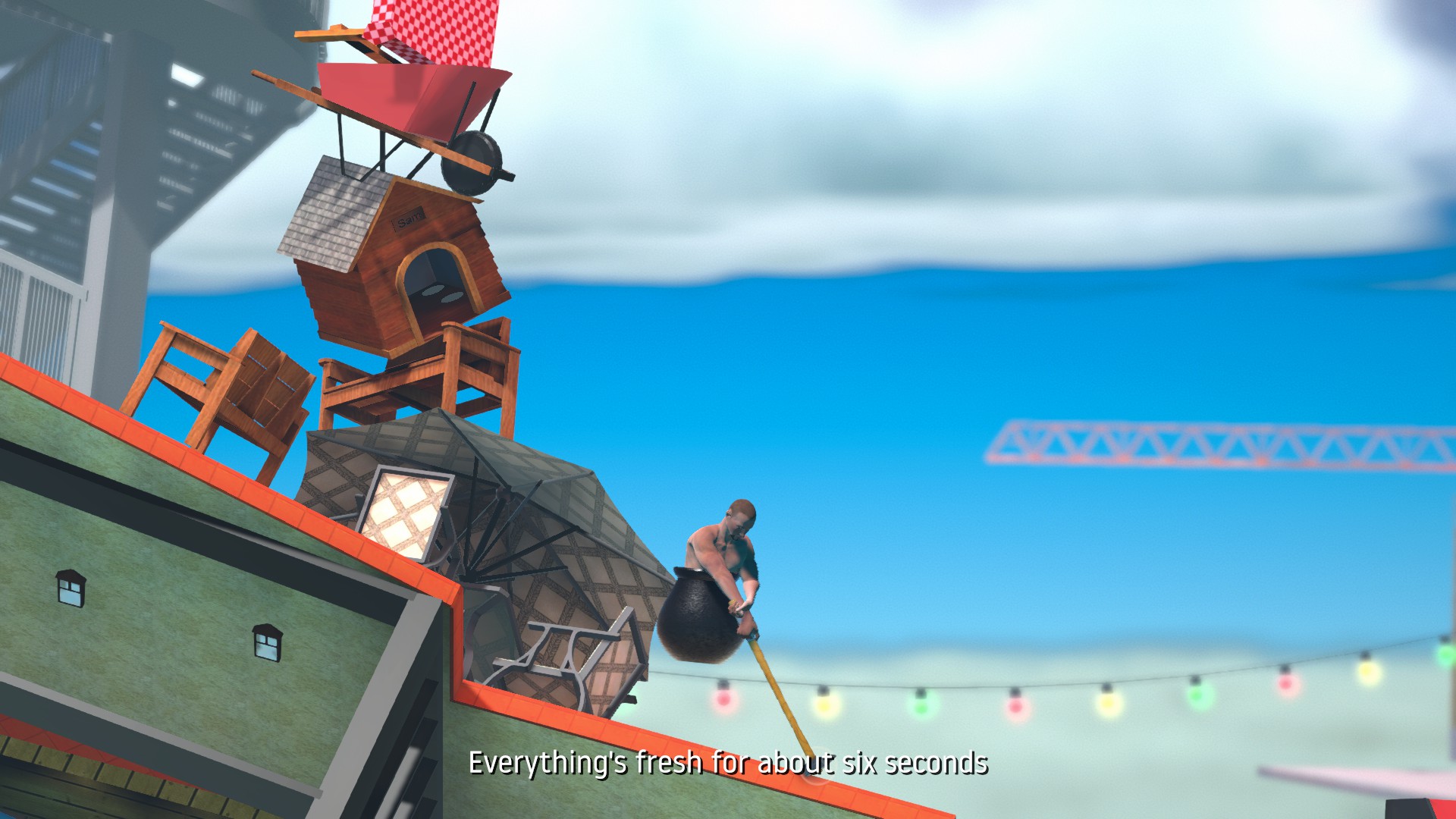From punishing run-and-guns like Cuphead to Hollow Knight’s take on the already difficult Metroidvania formula, gamers had plenty of titles to rage quit over in 2017. But one game in particular left some frothing at the mouth.
The premise of Getting Over It with Bennett Foddy, an indie PC platformer released in October, is simple: get to the top of the mountain using a hammer controlled by your mouse to grip onto obstacles. But with Foddy, the game’s developer and narrator, as well as the devilish mind behind QWOP, things are never quite that easy. Wonky physics and an increasingly difficult landscape make every inch gained a battle, and if (when) you fall, you lose that progress permanently.
But as players overcome the pitfalls of their climb, what they may not notice is the metaphysical struggle happening before their eyes. Foddy left several clues highlighting this philosophical symbolism peppered throughout his sarcastic narration. The biggest tell being the name of our hero, the man behind the hammer: Diogenes.
In this naming of his protagonist, Foddy calls back to one of the founding minds of Cynic philosophy: ancient Greece’s Diogenes of Sinope. Diogenes believed true happiness could only be achieved by living simply, through meeting one’s natural needs instead of those imposed by society. And so he cast off all worldly goods, took to begging, and made his home inside an abandoned cask – thus why Getting Over It’s protagonist resides in a pot. Around the fourth century BC, Diogenes’ frequent and fierce public displays of his belief inspired several tales of varying authenticity until he became known more as a character of the period than a philosopher.
To give you an idea of the man who’d become known as “Diogenes the Cynic,” he reportedly once threw away his only possession – a cup for food and drink – after seeing a child drink from a fountain with his hands. Diogenes then lamented, “A child his beaten me in plainness of living!” Alexander the Great was purportedly very fond of the philosopher, and visited him once in Athens during his travels. Alexander offered to grant him a favor, to which Diogenes shooed him away; the conqueror was blocking his sun.
But how does this relate back to a game about a bald man with superhuman upper-body strength propelling himself up a mountain? Well, if you unpack the narrator’s words a bit, he spells it out for you.

Foddy explains that his inspiration for Getting Over It came from a 2002 game called Sexy Hiking, an indie game also about climbing up a mountain with a hammer (who knew it was a genre?). Sexy Hiking typified B games, he argues, which are “rough assemblages of found objects” assembled quickly and at little expense at the cost of playability. “They’re built more for the joy of building them than as polished products,” Foddy explains.
Many have speculated, Foddy continues, that all video games will eventually be constructed through this assembly line process, with prefabricated objects reused over and over to populate our virtual playgrounds. But this argument doesn’t account for context. Just like food and water, media is consumable, so rapid-fire creation of it only results in an equally rapid-fire mounting of cultural trash as we burn through our endless feeds. And when a game is created from what the public perceives as trash, the game itself is then seen as, well, trash.
The mountain you climb in Getting Over It is built from these replicable B game assets; in short, it’s something out of Diogenes’ nightmares, its recycled nature becoming increasingly apparent the farther you climb. As you pass rocks and trees, a construction zone begins to take shape, materials laid out haphazardly in ways that aid your ascent. From there, everything begins to look like an M.C. Escher painting. Playgrounds and boxes defy gravity, living room furniture extends skyward in an impossibly balanced stack, stairs spiral into infinity.
And what does our hero Diogenes do when faced with such a tangible display of human consumption? Well, he gets over it. The player only has two methods of interacting with Foddy’s world after all: conquer the mountain, or stop trying. And as Diogenes climbs past the detritus left behind by worldly pursuits, his actions – and by extension the player’s – began to build a metaphor that parallels the teachings of Cynic philosophy. By overcoming reminders of his shallow desires and superficial needs, he’s reaching new heights in pursuit of something greater: fulfillment.
In this way, we can view Getting Over It as an extension of Diogenes’ quest to live a wholesome life according to his philosophy. The objects comprising the mountain, purposefully made to look like repurposed B game assets, further illustrate this point. Though they may be useless in and of themselves, the challenge they pose is very real since any one could be your literal downfall, sending you cursing and screaming back to the start of the game.

“Imaginary mountains build themselves from our efforts to climb them,” Foddy narrates. “And it’s our repeated attempts to reach the summit that turns those mountains into something real.” This parallels another piece of Diophenes’ philosophy: that the constant pursuit of satisfying superficial, societal needs distorted people’s realities. He reportedly often traveled through the Athens city square with a lantern in broad daylight, shining it in people’s faces in the pursuit of “a real human being,” he said. In this same vein, societal expectations become the imaginary mountain Foddy speaks of: self-imposed, but becoming real in our repeated attempts to succeed within their confines. Ironic, considering Getting Over It is yet another imaginary mountain by that definition. No one is forcing the player to continue tackling its difficult challenge. But, then again, no one was forcing Diogenes the Cynic either.









Published: Jan 12, 2018 12:51 am